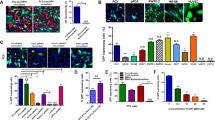Abstract
Retroviral infection is restricted by the expression of a viral receptor on the surface of the target cell. Retrovirus-mediated gene transfer is therefore not possible in cells that fail to express sufficient levels of the appropriate receptor, representing one major obstacle to the use of recombinant retroviruses in experimental and clinical applications. In this study, we utilized an adenoviral vector to express transiently the receptor for the ecotropic murine leukemia virus in a panel of human cell lines. Following adenoviral infection, the susceptibility to ecotropic retroviral particles of A549, HeLa, RC39 and Meso 33 cells, derived from human lung epithelium, cervical epithelium, kidney and mesothelium, respectively, was measured on a single-cell basis by the detection of a cell surface marker encoded by the recombinant retrovirus. The marker, termed NTP, was found in 10–30%, 25–50% and 50–90% of cells infected at 5, 50 and 250 adenovirus multiplicity of infec-tion, respectively. Southern blot analysis demonstrated the integration of intact retroviral DNA. The integrated vector copy number increased with the adenoviral multiplicity of infection, suggesting that retrovirus infection is proportional to receptor expression by the target cell, albeit not in a linear fashion. Susceptibility to ecotropic retroviral infection was maintained undiminished for at least 3 days, indicating the persistent expression of ecotropic receptor by the adenovirus-transduced cells in that time period and the lack of a major cellular defense triggered by adenovirus infection against the subsequent retroviral infection. Thus, the infection of human cells of various tissues with a recombinant adenovirus expressing the ecotropic murine leukemia virus receptor generates a window of susceptibility where a high retroviral infection rate can be achieved. Increased efficiency of retroviral infection obtained in this fashion is amenable to specific regulation via the controlled expression of the adenovirus-encoded retroviral receptor.
This is a preview of subscription content, access via your institution
Access options
Subscribe to this journal
Receive 12 print issues and online access
$259.00 per year
only $21.58 per issue
Buy this article
- Purchase on Springer Link
- Instant access to full article PDF
Prices may be subject to local taxes which are calculated during checkout
Similar content being viewed by others
Author information
Authors and Affiliations
Rights and permissions
About this article
Cite this article
Scott-Taylor, T., Gallardo, H., Gänsbacher, B. et al. Adenovirus facilitated infection of human cells with ecotropic retrovirus. Gene Ther 5, 621–629 (1998). https://doi.org/10.1038/sj.gt.3300633
Received:
Accepted:
Published:
Issue Date:
DOI: https://doi.org/10.1038/sj.gt.3300633



